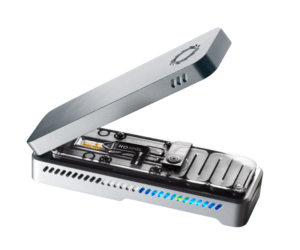Written by Emil Luca: MinION Nanopore Sequencer is a portable nucleic acid sequencer from Oxford Nanopore Technologies (UK).
MinION nanopore sequencer is unique for being pocket sized: 105 mm x 23 mm x 33 mm. It weighs 87 g. It is connected to laptop via USB for data transfer and it is powered by laptop.
MinION nanopore sequencer uses a flow cell which contains an array of tiny holes — nanopores — embedded in an electro-resistant membrane. Nanopore sequencing is based on the principle that when a single molecule passes through a nanopore with an ionic current flowing through it, the molecule disrupts the current resulting in a characteristic electrical signal.
A strand of DNA or RNA is made up of a sequence of different combinations of four nucleotide bases: A, T (or U for RNA), G and C. Each base that passes through the nanopore can be identified through the characteristic disruption it causes to the current in real-time. The information-rich signal is then decoded using base calling algorithms to determine the DNA or RNA sequence in real-time.
When sequencing DNA or RNA with nanopores, the changes in current caused by the strand of DNA or RNA as it passes through the pore are recorded by the MinKNOW™ software which runs all of Oxford Nanopore’s sequencing devices. The processive movement of bases through the pore leads to a continual change in current, known as the “squiggle”. MinKNOW processes the squiggle into reads in real-time, each read corresponding to a single strand of DNA/RNA. These reads are written out into FAST5 files, which can be converted to the FASTQ format, readable by both machines and humans. The raw data contains information on not only canonical bases but also base modifications, such as methylation.
Traditional methods are only able to sequence short lengths of DNA which must then be reassembled. It is therefore difficult to sequence repetitive regions for accurate genome assemblies without gaps, resolve large structural variations, or differentiate isoforms. Nanopore sequencing is limited only by the length of the DNA/RNA fragment presented to the pore and can therefore span entire repetitive regions, resolve structural variants, and differentiate between different isoforms. The ability to sequence native DNA and RNA without the requirement for amplification, eliminates PCR bias and allows for the identification of base modifications, such as methylation, alongside nucleotide sequence.
Nanopore sequencing is unique in that it enables direct, real-time analysis of short to ultra-long fragments of DNA/RNA. Advantages of real-time sequencing include rapid access to time critical information (e.g., pathogen identification), the generation of early sample insights and more control over the sequencing experiment.
MinION nanopore sequencer is suitable for different applications, including whole genomes/exomes, metagenomics, targeted sequencing, whole transcriptome cDNA, small transcriptome direct RNA, and multiplexing for small samples.
Despite its compact size, MinION is a powerful machine. You can get up to 50 Gb data from a single flow cell, which is the theoretical maximum output when the system is run for 72 hours at 420 bases/second. Being portable makes sequencing feasible anywhere, including at sample source. Thus, it is very much suitable for field work. Real time data streaming produces immediate, rapid, actionable results.
Nanopores read the length of DNA or RNA presented to them, from short to ultra-long (longest >4 Mb). This unrestricted read length allows ultimate experimental flexibility.
MinION costs from $1,000 for a starter pack that includes one flow cell and one library preparation kit.
The writer declares no conflict of interest. Specific information about this product are obtained from the manufacturer’s website. Inquiries are to be addressed to the manufacturer.

You forgot that this device could accept an accessory (Flongle), adapting for smaller, frequent, rapid tests and analyses.
Flongle is an adapter for MinION (105x 23x 8 mm, 20 g) that enables direct, real-time DNA sequencing, or cDNA sequencing on smaller, single-use flow cells. Only $90 per flow cell, it is cost-efficient. It allows sequencing of smaller assays, up to 2.8 Gb. You can run single samples on demand instead of multiplexing. It is available at starter packs from $1,460, including Flongle adapter and 12 flow cells.
https://nanoporetech.com/products/flongle